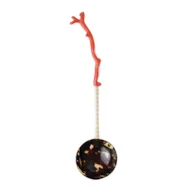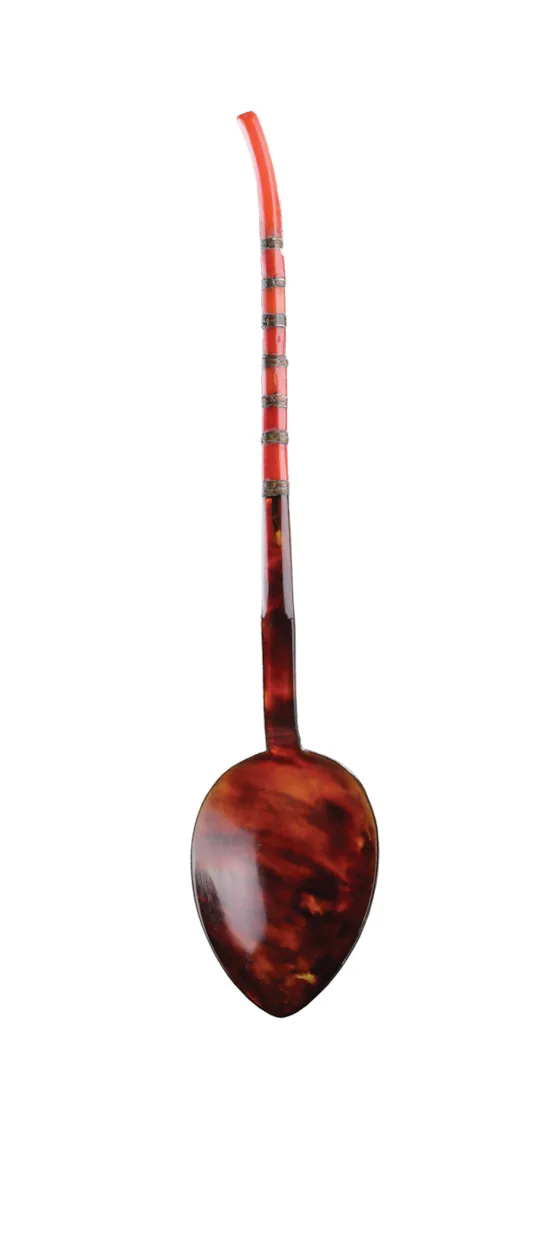A Fine Ottoman Turkish Sherbet Spoon and a Delicate Ottoman Turkish Sherbet Spoon with Tear Shaped Tortoiseshell Bowl
A Fine Ottoman Turkish Sherbet Spoon with Tortoiseshell Bowl Ivory Stem with Turned Simulated Rope Twist Design and a Large Natural Coral Finial
Late 18th - Early 19th Century
Size: 25.5cm long - 10 ins long
and
A Delicate Ottoman Turkish Sherbet Spoon with Tear Shaped Tortoiseshell Bowl and Coral Stem and Brass Segment Finial
Size: 21cm long - 8¼ ins long
Late 18th - Early 19th Century
Size: 25.5cm long - 10 ins long
and
A Delicate Ottoman Turkish Sherbet Spoon with Tear Shaped Tortoiseshell Bowl and Coral Stem and Brass Segment Finial
Size: 21cm long - 8¼ ins long
A Fine Ottoman Turkish Sherbet Spoon with Tortoiseshell Bowl Ivory Stem with Turned Simulated Rope Twist Design and a Large Natural Coral Finial
Late 18th - Early 19th Century
Size: 25.5cm long - 10 ins long
NOW SOLD
and
A Delicate Ottoman Turkish Sherbet Spoon with Tear Shaped Tortoiseshell Bowl and Coral Stem and Brass Segment Finial
Size: 21cm long - 8¼ ins long
Late 18th - Early 19th Century
Size: 25.5cm long - 10 ins long
NOW SOLD
and
A Delicate Ottoman Turkish Sherbet Spoon with Tear Shaped Tortoiseshell Bowl and Coral Stem and Brass Segment Finial
Size: 21cm long - 8¼ ins long
The Ottomans liked using multiple materials in combination and the craftsmen at the Topkapi Palace produced many luxury items using exotic materials from around the world. Artists, architects and craftsmen engaged in all the various decorative arts were employed and lodged within the grounds of the palace. Rather than relying on placing orders with independent masters, the Ottomans kept co-opting the best artists they could find into their own palace workshops. Records show that at the beginning of the 16th century over 360 artisans were employed and that by the end of the century this number had risen to over 1500 craftsmen, all on the payroll of the palace. However by the end of the 18th century their number had been considerably reduced to a mere 186.
Topkapi Palace formed the centre of the Ottoman world. For almost four centuries the palace patronised the fine arts producing textiles, jewels, carpets, calligraphy, arms and armour, manuscripts and bookbinding. The palace servants and concubines were recruited from far-flung provinces of the empire and the Ottoman rulers also had a penchant for precious stones and exotic materials and these also imported from distant shores were then used to achieve the most magnificent results possible in the palace workshops. For wealthy Europeans these luxury goods became status symbols whilst in the early 1800’s, from London to Paris, it became the height of fashion to dress ‘à la Turca’.
Topkapi Palace formed the centre of the Ottoman world. For almost four centuries the palace patronised the fine arts producing textiles, jewels, carpets, calligraphy, arms and armour, manuscripts and bookbinding. The palace servants and concubines were recruited from far-flung provinces of the empire and the Ottoman rulers also had a penchant for precious stones and exotic materials and these also imported from distant shores were then used to achieve the most magnificent results possible in the palace workshops. For wealthy Europeans these luxury goods became status symbols whilst in the early 1800’s, from London to Paris, it became the height of fashion to dress ‘à la Turca’.
A Fine Ottoman Turkish Sherbet Spoon and a Delicate Ottoman Turkish Sherbet Spoon with Tear Shaped Tortoiseshell Bowl






